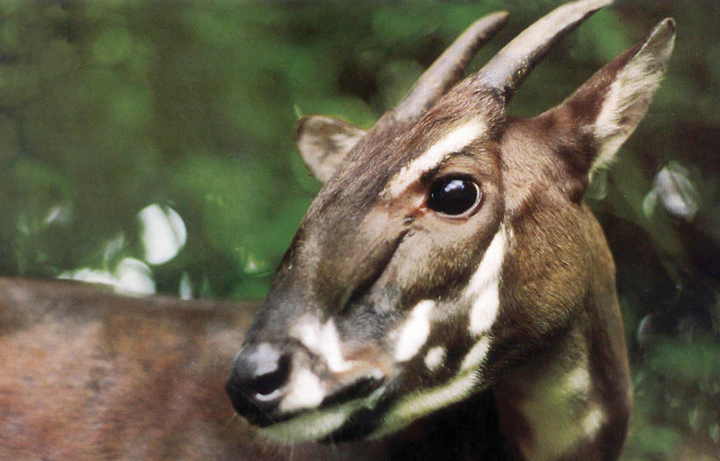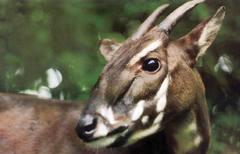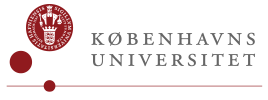Saving the Asian Unicorn – If It Still Exists
The saola, an antelope-like bovine, is one of the world’s rarest and most endangered mammals. In fact, it hasn’t been observed in over 10 years. Researchers from the University of Copenhagen, in collaboration with Vietnamese scientists and an international team of researchers, have for the first time mapped the saola’s complete genome, and they have used that knowledge to estimate the chances of saving it – if it still exists.

Is it extinct, or does it still roam somewhere deep in the misty highland forests of Vietnam and Laos? It has been nicknamed the Asian unicorn due to its almost mythical rarity, and it is the most recently discovered large land mammal, becoming known to science as late as in 1992. Even then, it was already endangered. Today, even the most optimistic estimates say fewer than 100 saola individuals (Pseudoryx nghetinhensis) remain, but it could also be extinct by now. The last confirmed sighting in the wild was in 2013.
Researchers have been searching for it ever since, but so far without success. The task is made even more difficult by the fact that the saola lives only in the remote, rugged forests of the Annamite Mountains in Vietnam and Laos.
"Right now, the existence of live saolas can neither be proven nor disproven. The last evidence we have was from 2013, when one was captured on a camera trap. But given the remoteness of its habitat, it is extremely difficult to say for sure whether there are still a few out there. There are some signs and indications that still give us hope”, says Nguyen Quoc Dung from the Forest Inventory and Planning Institute in Vietnam.
He is one of the authors of a new international study (DOI: 10.1016/j.cell.2025.03.040), in which researchers from Denmark, Vietnam and many other countries have mapped the saola’s genome for the first time ever. Up until now, almost no genetic data on the saola have been generated. The study is published in the scientific journal Cell.
By analyzing fragments from saola remains collected from hunters’ households, the researchers generated complete genomes for 26 saolas. This has provided brand new insights into the history of the enigmatic bovine – and its future prospects.
How It Might Survive
“We were quite surprised to find that the saola is split into two populations with considerable genetic differences. The split happened between 5,000 and 20,000 years ago. That was completely unknown before, and there was also no way we could have known without genetic data. It is an important result because it affects how the genetic variation in the species is distributed,” says lead author Genís Garcia Erill, a former PhD student at the Department of Biology.
The genetic analyses also show that both populations have been in decline since the last Ice Age. According to the researchers’ estimates, the total saola population never exceeded 5,000 individuals in the last 10,000 years. And this long-term decline means that both populations began losing genetic diversity. But crucially, they did not lose the same genetic diversity.
“This means that the genetic variation lost in each population complements the other. So, if you mix them, they could compensate for what the other is missing,” says Genís Garcia Erill.
And that could potentially be the solution to saving the saola from extinction. The researchers have calculated the probability of the species surviving under various conservation scenarios.
Their models show that the best survival chances occur if the two populations are mixed in a captive breeding program.
“If we can bring together at least a dozen saolas – ideally a mix from both populations – to form the foundation of a future population, our models show the species would have a decent chance of long-term survival. But it hinges on actually locating some individuals and starting a breeding program. That has worked before when species were on the brink of extinction,” says Rasmus Heller, senior author of the study and Associate Professor from the Department of Biology at UCPH.
But Does It Even Still Exist?
Finding 12 saolas, however, is no simple task. But the new research might help solve that problem. The genetic mapping opens up new possibilities for using various technologies to locate the last remaining saolas.
“Many researchers have unsuccessfully tried to find traces of saola through methods like environmental DNA in water and even in leeches, the blood suckers inhabiting the same habitat. These techniques all rely on detecting tiny DNA fragments, and now that we know the complete saola genome, we have a much larger toolkit for detecting those fragments,” says Minh Duc Le, co-author on the study from Vietnam National University.
But even if it turns out the saola is extinct, the new research findings might still be useful:
“Our results could in theory be used if we were ever to succeed in bringing the saola back through genetic de-extinction technologies, which are a hot topic right now. In that case, our new insights into saola genetic variation could make a huge difference in creating a viable population,” says Rasmus Heller.
Still, he has his doubts about the chances of finding living saolas.
“Scientists have been searching for saolas since the 1990s, and it’s only gotten harder since then, because there were more of them back then. I’m not overly optimistic, I have to admit – but I really hope the saola is still out there,” Rasmus Heller concludes.
ABOUT THE SAOLA
- The saola (Pseudoryx nghetinhensis) was discovered by science in 1992, making it the most recently discovered large mammal. The second-most recent was the kouprey, discovered in 1937.
- Danish and Vietnamese biologists have been working together on studying the secretive saola right from the very beginning – starting with the scientific description of the saola in the early 1990s.
- According to the IUCN, fewer than 100 individuals likely remain, making the saola one of the most endangered mammals in the world.
- The saola is evolutionarily unique – it sits on a 12–15 million-year-old branch of the tree of life and is the only surviving descendant on that branch.
ABOUT THE STUDY
- An international team of researchers from many countries and institutions contributed to the study, which is published in the journal Cell (DOI: 10.1016/j.cell.2025.03.040)
- The study was supported by the Vietnamese Ministry of Science and Technology, the European Research Council, the Carlsberg Foundation and Independent Research Fund Denmark, among other sources.
Keywords
Contacts
Rasmus Heller
Associate Professor
Department of Biology
University of Copenhagen
rheller@bio.ku.dk
+45 29299227
Minh D. Le
Associate Professor
Head of eGenomic Analysis and Conservation Research Group
Faculty of Environmental Sciences
University of Science, Vietnam National University, Hanoi
le.duc.minh@hus.edu.vn
+84 983456098
Maria Hornbek
Journalist
University of Copenhagen
maho@adm.ku.dk
+45 22 95 42 83
Images

Links
ABOUT THE FACULTY OF SCIENCE
The Faculty of Science at the University of Copenhagen – or SCIENCE – is Denmark's largest science research and education institution.
The Faculty's most important task is to contribute to solving the major challenges facing the rapidly changing world with increased pressure on, among other things, natural resources and significant climate change, both nationally and globally.
Subscribe to releases from Københavns Universitet - Det Natur- og Biovidenskabelige Fakultet
Subscribe to all the latest releases from Københavns Universitet - Det Natur- og Biovidenskabelige Fakultet by registering your e-mail address below. You can unsubscribe at any time.
Latest releases from Københavns Universitet - Det Natur- og Biovidenskabelige Fakultet
Bakterier bruger gammelt krigstrick til at overliste vira: Kan hjælpe med at bekæmpe ’superbugs’30.4.2025 07:30:00 CEST | Pressemeddelelse
Forskere har opdaget en ny type immunforsvar i coli-bakterier, der vender en virusinfektion mod vira selv. Systemet er opkaldt efter den kinesiske militærstrateg Kongming som var berømt for at bruge fjendens våben til at besejre dem. Opdagelsen kan bruges i udviklingen af fremtidige bioteknologiske værktøjer og måske som et alternativ til antibiotika til at bekæmpe multiresistente bakterier.
Nyt forskeruddannelsesprogram skal udklække fremtidens kvantespecialister29.4.2025 10:24:11 CEST | Pressemeddelelse
Med støtte fra Villum Fonden opretter Københavns Universitet og DTU et nyt forskeruddannelsesprogram, der skal være med til at sikre, at Danmark kan bevare sin styrkeposition inden for kvanteforskning i fremtiden.
Ancient grain has huge climate potential and could play a key role in Europe’s future8.4.2025 11:41:23 CEST | Press release
Sorghum is one of the world’s oldest grains and possesses many traits that can benefit food security, climate resilience, and biodiversity. However, the mechanisms behind these traits have long remained a mystery to researchers, which has hindered efficient cultivation. Now, a new technique and a biobank - developed in collaboration with the University of Copenhagen - have made research and breeding possible at an unprecedented pace, paving the way to an effective crop in both the Global North and South.
Ældgammel kornsort har kæmpe klimapotentiale og kan blive vigtig i Europas fremtid8.4.2025 11:11:07 CEST | Pressemeddelelse
Sorghum er en af verden ældste kornsorter og har mange egenskaber, der kan gavne fødevaresikkerhed, klima og biodiversitet. Mekanismerne bag egenskaberne har dog været en gåde for forskerne, og det har stået i vejen for en effektiv dyrkning. Ny teknik og biobank, udviklet i et samarbejde med Københavns Universitet, åbner nu for forskning og forædling i turbogear. Det kan bane vej til en effektiv afgrøde i både det globale nord og syd.
Core samples from Greenland's seabed provide first historical overview of plastic pollution21.3.2025 10:52:58 CET | Press release
By coring the seabed at 850 m water depth in Disko Bay off Greenland's west coast, researchers from the University of Copenhagen have obtained the first historical record of plastic pollution in Greenland. The new data suggest a link to local socio-economic development and represent a step towards developing a common method for analyzing and mapping global microplastic pollution.
In our pressroom you can read all our latest releases, find our press contacts, images, documents and other relevant information about us.
Visit our pressroom